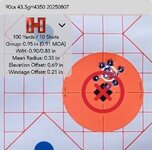I'd load 43.5 and roll with it, because it should be far enough out of pressure signs to not have issues, and it's easy to remember using H4350. 3 shot samples from an OCW are statistically meaningless, you need a 10 or 20 shot sample at the same charge weight to extrapolate anything valid about the dispersion that load will produce.
Navigation
Install the app
How to install the app on iOS
Follow along with the video below to see how to install our site as a web app on your home screen.
Note: This feature may not be available in some browsers.
More options
Style variation
You are using an out of date browser. It may not display this or other websites correctly.
You should upgrade or use an alternative browser.
You should upgrade or use an alternative browser.
Great range results, unexpected velocity-- Pressure?
- Thread starter BringBackThe80s
- Start date
BringBackThe80s
FNG
- Joined
- Sep 5, 2023
- Messages
- 47
I did a full barrel cleaning, shot 5 fouling shots, then shot this 0.9 MOA 10-shot group, pausing every two shots to let the barrel cool ~10 minutes.I'd load 43.5 and roll with it, because it should be far enough out of pressure signs to not have issues, and it's easy to remember using H4350. 3 shot samples from an OCW are statistically meaningless, you need a 10 or 20 shot sample at the same charge weight to extrapolate anything valid about the dispersion that load will produce.
For this group I dropped down to 43.5 grains of H4350 for an average MV of 3095. Shots 1-5 of this group were a bit scattered and had an ES of a 90fps. Shots 6-10 clumped up into a half inch with a lower ES. It looks like the fairly rough bore of this rifle needs about 10 shots to get fully settled after cleaning.
I would prefer to see all shots touching like I did with 5- and 7-shot groups at 44.0 grains. But I guess I shouldn't begrudge consistently sub-MOA groups from a completely factory rig that cost under a grand with optic and accessories.
Attachments
BringBackThe80s
FNG
- Joined
- Sep 5, 2023
- Messages
- 47
The wild ES with this group was a big departure from the consistency I got on the previous groups using 44.0 grains (those had ES of ~10 fps, SD of 2-3 fps). The 90-100 ES I got with this group would show up as 9-10" of vertical spread at 500 yards.
I'll shoot another 10-20 shot groups with this charge weight and see if the velocity swings go away. If not, I'll check for better consistency at at 42.3 or 42.5 grains (GRT predicts a node around there).
I'll shoot another 10-20 shot groups with this charge weight and see if the velocity swings go away. If not, I'll check for better consistency at at 42.3 or 42.5 grains (GRT predicts a node around there).
I really think it's because the barrel wasn't fully fouled back up and will calm down, I know it's common to see the higher round count barrels take more rounds to settle back in after a cleaning, which is why I don't clean anymore.The wild ES with this group was a big departure from the consistency I got on the previous groups using 44.0 grains (those had ES of 10-15fps, SD of 2-3 fps).
Not exactly, because of random dispersion it could hold tight because the slow ones could be the high shots out of the group, and the fast ones could be the low. This is why I quit putting so much stock into velocities, and regularly see 50+fps spreads on larger sample sizes that shoot completely fine at distance.The 90-100 ES I got with this group would show up as 9-10" of vertical spread at 500 yards.
Awesome, looking forward to the results!I'll shoot another 10-20 shot groups with this charge weight and see if the velocity swings go away. If not, I'll check for better consistency at at 42.3 or 42.5 grains (GRT predicts a node around there).
BringBackThe80s
FNG
- Joined
- Sep 5, 2023
- Messages
- 47
That's a good point about potential benefit of angular dispersion. I forget points like that. Around here, it has hard to find rifle ranges longer than 100 or 200 yards. A few years ago we got our first 1,000 range within a 1 hour drive. Before that, you had to spend a half day driving to find anything like that. Most of my hunting has been archery and smokeless muzzleloader, so these two rifles are my first efforts at being equipped for long range.Not exactly, because of random dispersion it could hold tight because the slow ones could be the high shots out of the group, and the fast ones could be the low. This is why I quit putting so much stock into velocities, and regularly see 50+fps spreads on larger sample sizes that shoot completely fine at distance.
Rather than more messing around at 100 yards, maybe I should go ahead and make the drive to see how this load shoots 10 or 20 shots at 300 and/or 600 yards.
Similar threads
- Replies
- 18
- Views
- 496
- Replies
- 8
- Views
- 551
- Replies
- 23
- Views
- 991
Featured Video
Latest Articles
- TT#64 Josh Boyd Elk Hunting Strategies for Every Season
- Aaron Davidson of Gunwerks
- TT#63 Dirk Durham’s Art of Elk Calling
- BIG Buck Stories with the Dirty Giants Podcast
- TT#62 Brian Barney Hunting Bulls without Calling
- Hoyt Alpha AX-2 SD Review
- Kuiu Kenai vs Outdoor Vitals Vario Hooded Jacket Review
- Hoyt RX-9 Ultra Review
- Hunting Vampire Bucks & Building an Optics Kit
- Darton Sequel ST2 35 Review

